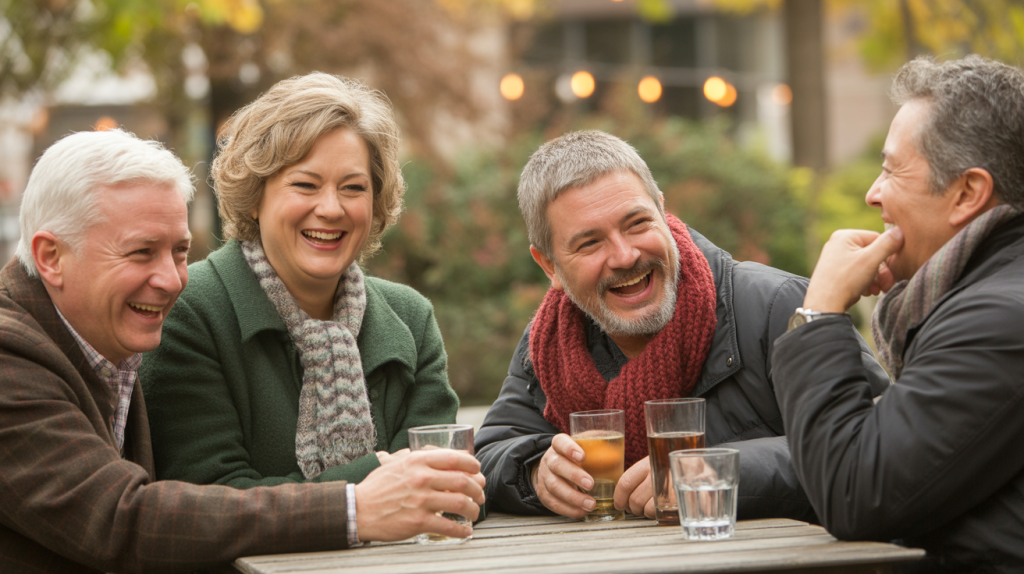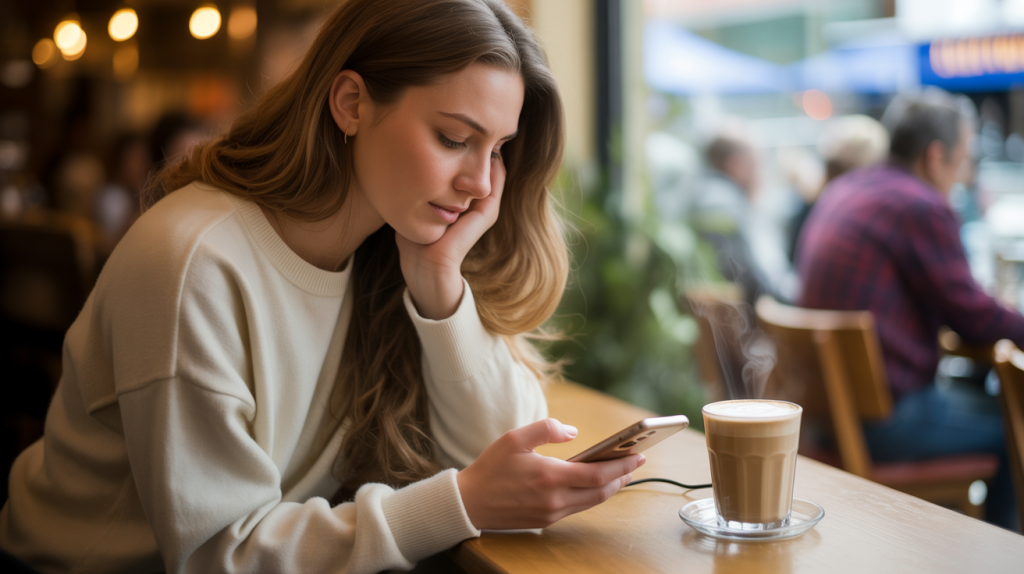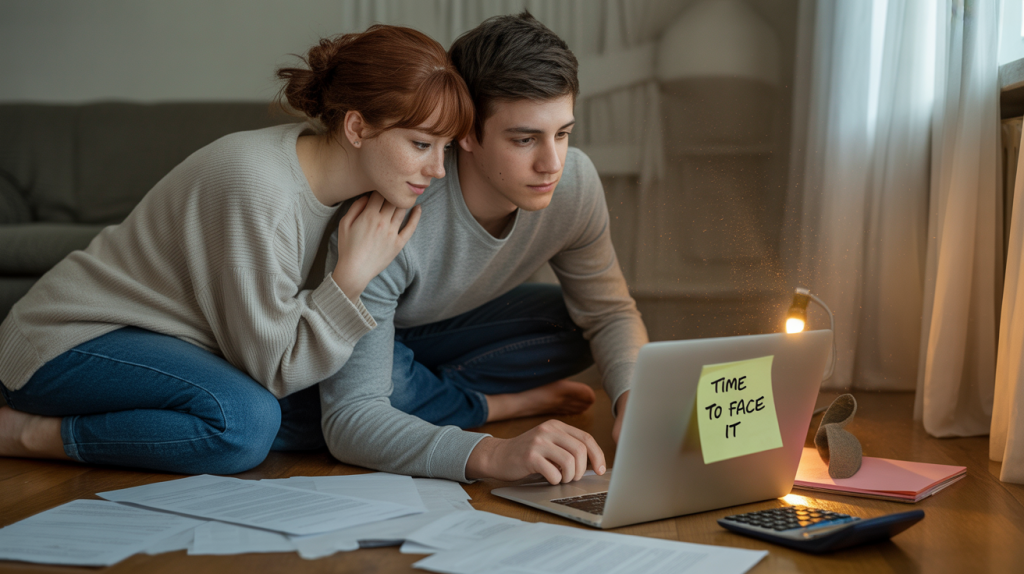It started, as many modern financial crises do, with a quiet moment and a glowing screen. I was sitting at my kitchen table, a half-empty cup of coffee cooling beside me, scrolling through my credit card statement online. It wasn’t a matter of not being able to pay the bill. Thank goodness, I’ve always been responsible in that regard. It was something more unsettling. I didn’t recognize my own life in the list of charges.
There was a $4.99 charge here, a $12.95 there. A tap at the coffee shop, a click on an online ad, a subscription I’d forgotten I’d even signed up for. Each transaction was a tiny, insignificant drop. But together, they had formed an ocean of spending I couldn’t quite account for. It was like I had a financial leak, a slow, steady drip of dollars vanishing into the digital ether. The money was leaving my account, but I wasn’t feeling its absence. There was no friction, no moment of decision—just the seamless, silent swipe or click.
That feeling of disconnect bothered me more than the total on the statement. I felt like a passenger in my own financial life, not the driver. And I decided, right then and there, that I needed to do something drastic. I needed to make my money real again. I’d heard people talk about the cash-only envelope system for years. It always sounded so… archaic. A relic from my parents’ or grandparents’ generation. But maybe that’s exactly what I needed. A return to something tangible. A financial reset.
So, I made a pact with myself. For one month—thirty days—I would ditch the plastic. I would live on cash, divvied up into envelopes for every spending category. It was a terrifying and exhilarating idea. I had no idea if I could do it, or what I would learn along the way. But I knew I had to try. This is the story of what happened.
The Point of No Return: Why I Had to Make a Change
Let me be clear: I wasn’t in financial ruin. I was, by most measures, doing just fine. I paid my bills on time, had some savings, and lived within my means. The problem was a creeping sense of carelessness. The convenience of modern banking had become a curse. “Tap to pay” meant “tap to not think.”
My pre-experiment ritual was probably familiar to many. I’d use my debit card for small things—a gallon of milk, a coffee—and my credit card for larger purchases, like groceries or gas, to get the rewards points. Online shopping was a constant temptation. A few clicks on Amazon, and a package would appear at my door two days later, the financial transaction a distant memory.
The real catalyst was a recurring charge for a digital streaming service I hadn’t used in at least six months. It was only $14.99, but seeing it there, month after month, was like a small betrayal. My own money was being spent without my active consent, on something that brought me zero value. I went hunting for other such “zombie charges” and found a few more. A magazine subscription, a premium app feature. Together, they added up to nearly $50 a month. Fifty dollars I was essentially throwing away for nothing.
It was proof of my theory: my spending had become automated and unconscious. I wasn’t making choices; I was letting my past choices run on a loop. I yearned for intention. I wanted to feel every dollar I spent, to make a conscious decision about its purpose. The cash envelope system, with its physical boundaries and finite resources, seemed like the only way to force that to happen.
Getting Started: The Cash, The Envelopes, The Plan
The first step in this experiment felt both monumental and a little silly. I drove to my bank and stood in line to see a teller. I couldn’t remember the last time I’d done that. “I’d like to make a large cash withdrawal,” I said, feeling like I was in an old movie.
I had done my homework. I’d spent an evening with my last three months of bank and credit card statements, a notepad, and a calculator. I tracked every penny to understand where my money was truly going. Then, I created a budget—not a wishful-thinking budget, but a realistic one based on my actual spending, with some trims where I knew I could do better. This budget would be the foundation for my entire month.
At the bank, I withdrew the total amount I had budgeted for all my variable expenses for the next 30 days. This included everything except my fixed bills like my mortgage, insurance, and utilities, which I would continue to pay automatically from my checking account. Holding that thick stack of bills in my hand was a jolt to the system. It felt like an immense amount of money. It felt heavy, real, and a little bit dangerous. For the first time in a long time, I had a visceral understanding of the money I earned and spent.
Back at home, I laid out my tools: a pack of plain white business envelopes, a sharpie, and my wad of cash. The ritual of setting up the system was calming. I carefully labeled each envelope. This part is deeply personal, and my categories reflected my life.
My Envelope Categories and Why I Chose Them
- Groceries: This was my biggest category. I gave it a generous but firm budget. My goal was to stop impulse buys at the supermarket.
- Gas: A fairly predictable expense, but one I wanted to track separately.
- Household Items: For things like cleaning supplies, paper towels, and lightbulbs. I kept this separate from groceries to see how much I was really spending on non-food items.
- Entertainment/Dining Out: This was my “danger zone.” It included everything from a restaurant meal to a movie ticket or a coffee with a friend. I deliberately set this budget lower than my previous average. This was the envelope I was most nervous about.
- Personal Spending: A catch-all for things like a new book, a haircut, a birthday card, or a new shirt. This was my “fun money,” and when it was gone, it was gone.
- Pets: For food and treats for my golden retriever, Buddy. A non-negotiable expense.
- Miscellaneous/Buffer: I knew unexpected things would come up. This was a small “just in case” fund for a prescription copay or a last-minute need.
I counted out the cash for each category and sealed it in the corresponding envelope. Seeing my monthly income broken down into these little paper pockets was profoundly illuminating. The number for “Dining Out” looked so small when it was a finite pile of twenties and tens. The “Groceries” pile looked substantial, but I knew how quickly it could vanish. I put all the envelopes into a small accordion file and placed it in a secure drawer. My experiment was officially underway.
Week One: The Shock and Awkwardness of Living with Cash
The first week was a masterclass in humility and awkwardness. My digital-first brain had to be completely rewired. My first major test came two days in, at the grocery store.
I did my shopping as usual, but with a new sense of awareness. With every item I put in my cart, I did a rough mental calculation. At the checkout, the total came to $112.58. I reached into my purse, my hand bypassing my familiar wallet and fumbling for the “Groceries” envelope. I pulled it out, my cheeks flushing slightly as I unsealed it and counted out the bills.
I handed the cashier six twenty-dollar bills. She took them without batting an eye, her expression unchanging. All my self-consciousness was entirely in my own head. She handed me back my change, and I carefully tucked the $7.42 back into the envelope. The finality of that act was stunning. I could physically see how much I had left for the rest of the month’s groceries. It wasn’t an abstract number on an app; it was a visibly thinner stack of bills. I left the store feeling both flustered and strangely empowered.
The biggest challenge of the first week, however, was the siren song of the internet. I’m an avid reader, and I saw an ad for a book I’d been dying to read. My fingers instinctively moved to click “Buy Now.” And then I stopped. How could I? I had no “Online Shopping” envelope. My cash was in a drawer at home. I couldn’t just type in my credit card number.
I had a choice: I could break the rules just this once, or I could figure it out. I chose the latter. I wrote the title of the book on a sticky note and put it on my desk. I told myself I could use the money from my “Personal Spending” envelope to go to a local bookstore and buy it later in the week. The immediate gratification was gone, replaced by delayed planning. It was inconvenient. It was also, I realized, incredibly mindful.
By the end of the week, I felt like I was constantly swimming against the current. I had to remember to bring the right envelopes with me when I left the house. I had to make change. I had to say “no” to a friend’s suggestion to order takeout because I hadn’t budgeted for it that week. It was clunky and inefficient, and a part of me just wanted to go back to the easy way.
Week Two: Facing Temptations and Unexpected Hurdles
If week one was about logistics, week two was about emotion and temptation. I had the system down, but now I had to live with its consequences. The first real test came on a beautiful Tuesday afternoon when a good friend called out of the blue.
“I’m near your neighborhood,” she said. “Let’s grab a late lunch at that new cafe.”
My heart sank. My “Entertainment/Dining Out” envelope was already looking dangerously thin after a weekend meal out. I pulled it from my purse and counted the contents. I had exactly $18 left for the next two and a half weeks. There was no way I could afford a cafe lunch, where even a sandwich and an iced tea would cost more than that.
In the past, I would have said “Yes!” without a second thought, swiped my card, and dealt with the cost later. But now, I had a hard, physical limit. I felt a pang of disappointment and even a little resentment toward my own rules.
“You know,” I said, thinking fast, “it’s such a gorgeous day. Why don’t you come over here, I’ll make us some iced tea, and we can take a walk in the park?”
She agreed without hesitation. We ended up having a wonderful afternoon, and it cost me nothing but a couple of tea bags. This was a revelation. The envelope hadn’t deprived me of a social connection; it had just forced me to find a more creative and affordable way to achieve it. It was a huge win.
But life, as it does, threw a curveball a few days later. I got in my car to run an errand and a dashboard light came on. My tire pressure was low. I took it to the local garage, and they found a nail in one of the tires. The patch would be $30.
Thirty dollars. It wasn’t a catastrophe, but I hadn’t budgeted for it. There was no “Car Repair” envelope. This is where the system’s rigidity became a real problem. I stood there at the service counter, my mind racing. I had to pay for it. I ended up taking the money from my “Groceries” envelope, the one with the most cash in it. As I handed over the money, I felt a knot in my stomach. That $30 had to come from somewhere. It meant my food budget for the rest of the month was now significantly tighter. I would have to be extra careful with my meal planning and shopping lists.
This experience taught me a valuable lesson: a cash-only system needs a robust emergency or “miscellaneous” fund. My little buffer wasn’t enough. It also showed me how interconnected my financial decisions were. A nail in my tire directly impacted what I could afford to eat for dinner. It was a powerful, if stressful, illustration of financial cause and effect.
Week Three: The Shift to Mindful Spending
Something magical happened in the third week. The awkwardness began to fade, replaced by a quiet confidence. The system wasn’t a chore anymore; it was just the way things worked. My brain had finally accepted the new reality, and my habits started to shift in subtle but profound ways.
The turning point came during a trip to a home goods store. I was there to buy laundry detergent, using cash from my “Household Items” envelope. As I walked down the aisle, I saw a beautiful set of ceramic measuring cups. They weren’t expensive—maybe $20. The “old me” would have tossed them in the cart without a thought. They were lovely. I deserved them.
But the “new me” paused. I didn’t have a “Cute Kitchen Gadgets” envelope. The money would have to come from my “Personal Spending” envelope. I mentally pictured the cash inside it. I knew I was hoping to use that money to buy that book I wanted and maybe get a haircut next week. Did I want the measuring cups more than a haircut? I picked them up. They felt solid and well-made. I already had a perfectly functional set of plastic measuring cups at home. These were a want, not a need.
I stood there in the aisle for what felt like a long time, having a silent debate with myself. And then, I did something that would have been unthinkable a month ago. I put the measuring cups back on the shelf and walked away. I felt a surge of pride that was far more satisfying than the fleeting joy of an impulse purchase. I was in control. I was making a conscious choice that aligned with my larger goals.
This mindfulness seeped into other areas of my life. My grocery shopping became a strategic mission. I planned my meals for the week, made a detailed list, and stuck to it. I paid attention to prices and sales. I found myself wasting less food because I was so aware of the cost of every vegetable and piece of chicken. My “Dining Out” envelope was still slim, so I started making my coffee at home every morning, a habit I actually came to enjoy. It became a quiet, meditative start to my day.
The fear and anxiety of the first two weeks had been replaced by a sense of calm and order. I knew exactly where my money was. I knew how much I had left. There were no surprises, no end-of-month statement shocks. There was just the plan, and my daily choices within it.
The Final Week: Seeing the Results and Looking Back
As I entered the fourth and final week, I felt a sense of accomplishment. The envelopes were looking thin, but none were completely empty, save for the “Dining Out” one, which I had officially depleted on a celebratory slice of pizza two nights prior. I had survived.
On the last day of the month, I conducted a final audit. I gathered all my envelopes on the kitchen table, just as I had done at the beginning. I counted the remaining cash in each one.
– Groceries: $24.17 left.
– Gas: $11.50 left.
– Household Items: $6.80 left.
– Personal Spending: $32.25 left.
– Pets: $8.40 left.
– Miscellaneous/Buffer: Untouched.
I added it all up. I had more than $130 in cash left over from my variable spending budget. I was floored. Where did this money usually go? It went to the extra coffee, the magazine at the checkout, the online impulse buy, the takeout I ordered because I was too tired to cook. It went into that “digital ether” I had been so worried about.
When I compared my total spending for the month to my previous averages, the difference was even more stark. By cutting out the unconscious spending and being more mindful, I had saved over $400. The number was astounding to me. I hadn’t felt deprived. In fact, I felt richer. I felt more in control and less anxious about money than I had in years.
I took all the leftover cash and the untouched buffer money and put it into a new, freshly labeled envelope: “Future Adventure.” It felt amazing to give that saved money a real, exciting purpose.
My Biggest Takeaways From a Month of Cash-Only Living
This experiment was about so much more than just saving a few hundred dollars. It fundamentally changed my relationship with money. When I reflect on the journey, a few core lessons stand out.
Lesson 1: Money Isn’t Abstract
The single most important takeaway for me was realizing how abstract money had become. The cash system forced it to be concrete. Handing over five $20 bills for groceries feels profoundly different than tapping a card for $100. You feel the loss. That “pain of paying” is a powerful behavioral corrective. It makes you ask, “Is this purchase really worth it?”
Lesson 2: Planning Prevents Panic
The initial work of creating the budget and tracking my spending was the hardest part, but it was also the most crucial. That plan was my roadmap. When the tire incident happened, I was stressed, but I didn’t panic. I had a system to work within. Knowing exactly where your money is designated to go eliminates so much financial anxiety.
Lesson 3: Freedom Comes From Structure
This seems counterintuitive, but the rigid limits of the envelopes gave me an incredible sense of freedom. I never had to worry if I could “afford” something. I just had to look in the envelope. If the money was there, I could spend it guilt-free. If it wasn’t, the decision was already made for me. It removed the constant, low-level stress of financial guesswork.
Lesson 4: It’s Okay to Be Imperfect
The system isn’t perfect for the modern world. It makes online shopping difficult and can be cumbersome. I had to borrow from my grocery envelope for a car repair. But that’s okay. The goal isn’t to be a perfect budgeter overnight. The goal is to be more aware. The experience taught me to be flexible and to give myself grace.
Would I Recommend the Cash Envelope System? My Honest Answer
So, the big question: Am I still living on a 100% cash-only system? The honest answer is no. It’s not entirely practical for my life long-term. I value the convenience of online bill pay and using a card for gas on a cold day.
But the experiment was far from a failure. It was a resounding success because it permanently rewired my brain. Today, I use a hybrid system that is the direct result of what I learned. I still use cash envelopes for my two biggest “problem” categories: Groceries and Entertainment/Dining Out. Forcing myself to use cash in these areas keeps my spending in check where it’s most likely to get out of hand.
For everything else, I’ve returned to my debit card, but with a completely new mindset. When I tap my card for a coffee now, I feel it. I consciously register the expense in my mind. I am no longer a passive passenger. I am the driver, fully in control, with a clear map of where I’m going.
If you’re feeling that same sense of disconnect that I was, that feeling of your money just disappearing, I can’t recommend this experiment enough. You don’t have to do it for a year, or even a month. Try it for a week. Or just try it for one category of spending, like groceries. The simple, old-fashioned act of turning your digital dollars into physical cash might just be the most powerful financial tool you’ve ever used. It was for me.















